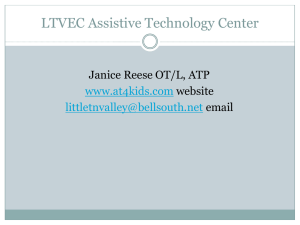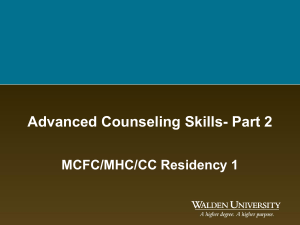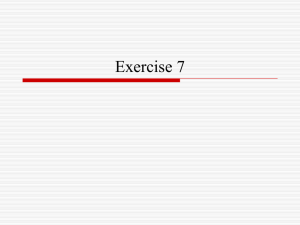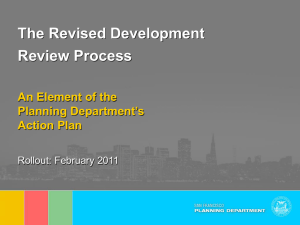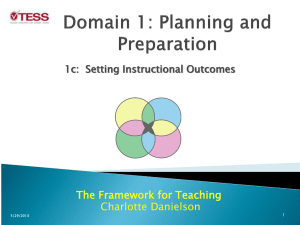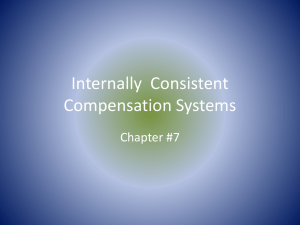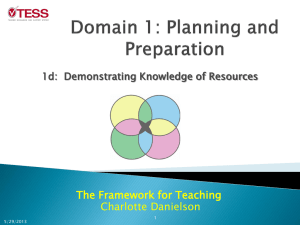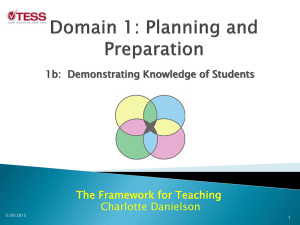Basic Attending Skills
advertisement
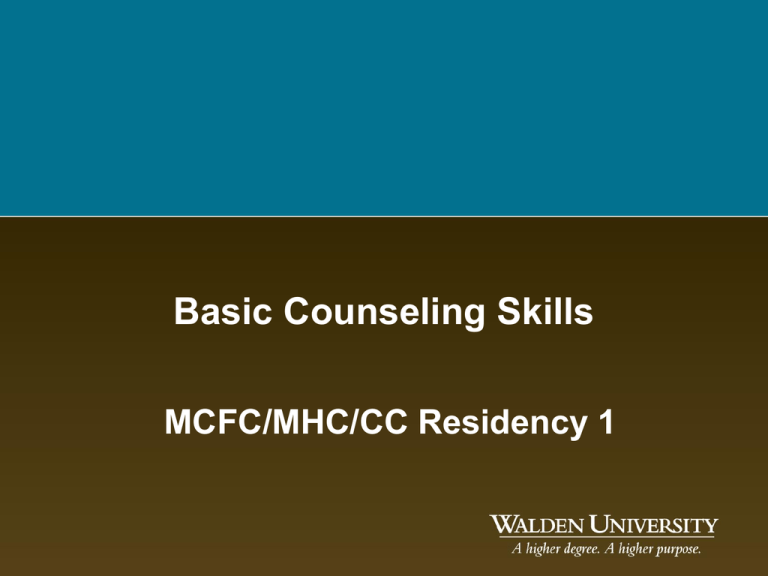
Basic Counseling Skills MCFC/MHC/CC Residency 1 Learning Objectives • From this presentation, you will be given information to: – Apply basic of counseling skills – Articulate why counseling skills are important – Explain the importance of rapport building – Define and discuss SOLER skills – Discuss appropriate use of verbal and nonverbal communication skills. May 2011 Revised Setting the Stage • Although your ultimate approach to helping will be influenced by what the client needs, what the client will respond to best, and what stage you are in, ultimately you need to create an environment that promotes feelings of safety, respect, and understanding. • The bulk of this relationship building occurs in the beginning stage of counseling and there are skills that are more effective for use during this time. May 2011 Revised The PERSON of the counselor Voice – have a soothing, comforting tone Eye contact - be natural with eye contact, be as animated as possible with your facial expression (but be careful showing shock…..) Language - keep in mind education level, experiences of those with whom you are working but be genuine in your own vocabulary Demonstration of confidence in process and directives EMPATHY May 2011 Revised The Counseling Setting Also consider your office: Arrangement of furniture - no big objects b/w you and client, Credentials – hang degree, licenses, certifications, registrations on wall Your comfort level May 2011 Revised Understanding the CONTEXT of the client • Remember first to understand the client in his or her context— • Consider: – The person of the client – How the client acts in session will elicit responses form you (if client is withdrawn, you may use skills that help bring him/her out; if client gregarious, you may use skills to cut-off) – Sensitivity to diversity May 2011 Revised The Client-Counselor Relationship • How the relationship itself assists you as a counselor: Diagnostic aid How the client acts in session is a clue to how he/she acts outside of session—patterns of behavior Interpersonal engagement This allows you to have influence over the client – be careful of this as you carry power in your role… social modeling, directives and challenges your reactions to their material how you deal with immediacy issues, etc.. Unfinished business Transference and countertransference reactions can be grist for the mill You can use the relationship to help heal from past (think Rogers and Gloria) May 2011 Revised The Client-Counselor Relationship • Personal support system – Research suggests the number one factor in clients improvement is support system (it’s best if this is both outside and inside the therapy) – Counselors should support clients, be a cheerleader for them – Support communicates • • • • • • someone is here for you you can count on someone I might not approve of what you are doing, but I approve of you there is a person in your life who is reliable and dependable you will not be taken advantage of my job is to help you get what you want May 2011 Revised The Client-Counselor Relationship • Authentic engagement – You will like some clients and dislike others, but you must be genuine and can use this as immediacy – If you have have strong reactions to liking or disliking a client it is imperative that you discuss this in supervision/ consultation. May 2011 Revised Basic Attending Skills • Purpose: – To help client tell story – Draw out appropriate background and contextual information – Communicate understanding – Facilitate deeper level of exploration make connections – Demonstrate empathy – Provide emotional support to the client May 2011 Revised Skill: Minimal Encourages • Prompts – Verbal (uh huh, go on, yes, hmmm,) – Nonverbal (bodily mvmts, gestures, nods) May 2011 Revised Skill: Probes • Probes should be used to help keep clients engaged in dialogue and provide client with enough structure to achieve concreteness and clarity while providing an opportunity to get necessary details of story. • Probes can also help clients get a balanced view of problem situations and opportunities. • Probes help clients get deeper into issues, move forward, and help in exploration of issues. • Probes can also challenge clients. May 2011 Revised Skill: Probes • Statements – “Tell me….” “I wonder….” “It’s still not clear to me…” “I’m not sure I understand…..” • Phrases that are actually questions or requests – “Share with me what you are thinking…” • Restating key words with question tone of voice – Example • Cl: I am tired of it all. • Co: Tired? May 2011 Revised Skill: Questions When to ask questions: • • • • • • • • Initially. “Where would you like to begin today?” When you need specific information For clarification (but you could always do a paraphrase) To get things back on track. “Earlier you said… what is….” To bring it in the here and now When you want to make a point or a connection. “What were you thinking just now when you heard me say that?” When you want to define goals. When you want to motivate the client into action. May 2011 Revised Skill: Questions Problems with Questions • Bombarding client • Too many questions in a row (particular text reads: then you have just asked 2 stupid questions!!) Using questions effectively • If you can make it a statement it’s better! – – – – Tell me…. Explain that… I wonder…. Talk more about that…. • Good idea to mix probes, statements, reflections May 2011 Revised Skill: Questions • Good and Bad questions – Avoid why. Why? • It sounds judgmental (think of when you got into trouble as a kid) • B/c clients don’t know why. (Think of when you had to give a reason why you got into trouble) • “Why” questions can be restated, sound less accusatory and elicit the same information. Instead of “why did you do that?” you may consider “Can you tell me how you made that decision? How did that work for you?” May 2011 Revised Skill: Questions • Good and Bad Questions: – Open and Closed • Open questions: – help elaborate and enrich the client story – help bring out the concrete specifics of the client’s world » what would an example be? – Closed gives basically a yes/no response – Fluff • If you are trying to fill “space”, it’s probably not a useful question • If you can reflect or use another skill, it’s always better May 2011 Revised Skill: Clarifying and Summarizing This is not restating or parroting, but summarizing. This shows the client you are paying attention. What is important? • Listen to what your heard • Ask yourself what is underlying message? Minisummarization: • A sentence stem: “I hear you say…” or “In your point of view…” or “Looks like…” • Use key words of clients • Stay true to client’s ideas.. they will correct if you are wrong (and that’s okay!) May 2011 Revised Skill: Clarifying and Summarizing – Summarize themes of long dialogue – Summarize at beginning of new session – Summarize at end of session – Clarify/Summarize when situation seems to not be going anywhere or client is rambling – Clarify/Summarize when client gets stuck or when clients needs new perspective May 2011 Revised Skill: Nonverbals Both client and counselor nonverbals can communicate volumes. • Client nonverbals can give context to the information the client is sharing, can support or discredit the validity of what the client is expressing, and can serve to provide additional understanding to words the client is using. • Counselor nonverbals also give clients clues about counselor confidence, degree to which counselor is listening to them, relationship trustworthiness. May 2011 Revised Skill: Nonverbals • Nonverbal information can be gained through observation of: – Facial expressions – Eye Contact (*consider cultural differences) – Appearance (clothing, grooming) – Gestures/Body movements (i.e., fidgety) – Spatial behavior (how did client position him/herself) – Posture May 2011 Revised Skill: Non-Verbal Attending • What information can be gathered from nonverbals? – Assessment of general mood – Clues to inner states – Mental status – Verbal and nonverbal congruency – Signals of distress – Unconscious reactions May 2011 Revised Skill: Nonverbals • List/ discuss nonverbal behaviors associated with these feelings: – Anger – Fear – Happiness – Sadness May 2011 Revised Skill: Counselor Nonverbals • So, what nonverbal behaviors indicate interest and caring? – SOLER (sit squarely, open posture, lean in, eye contact, and relax) – Also, your facial expression will show appropriate response – Minimal encouragers: head nods, uh huhs… May 2011 Revised Activity • Large Group Activity: – Play Telephone Game: – One person taps the next person on the shoulder and tells a 1-2 sentence story. That person will then tap the next person on the shoulder and share the same story. The story can only be told once per person. The last person to hear the story tells it to the group. May 2011 Revised Activity • Did the ending message remain the same as the beginning message? • WHY? - No context - No non-verbal - No “confirmation” May 2011 Revised Activity • Now, play the game with these instructions: – One person chooses a feeling, everyone closes eyes and starter taps person to right who then opens eyes and starter conveys emotion through facial expression… goes round the room – last person verbally identifies feeling May 2011 Revised Activity - HOMEWORK • Watch one television interview and reflect on it to identify nonverbals you can pick up on – for both interviewer and interviewee. For our purposes watch a television show (Dr. Phil, CSI, Law & Order, or any show that includes interviews and watch for the facilitators of communications.) May 2011 Revised References Egan, G. (2010). The skilled helper: A problem management and opportunity development approach to helping (9th ed.). Belmont, CA: Brooks/Cole (Cengage Learning). ISBN: 9780-495-60189-0 or 0-495-60189-6 hard. Egan, G. (2010). Exercises in helping skills: A manual to accompany the skilled helper (9th ed.). Belmont, CA: Brooks/Cole (Cengage Learning). ISBN: 978-0-495-80632-5 or 0-495-80632-3 soft. May 2011 Revised
